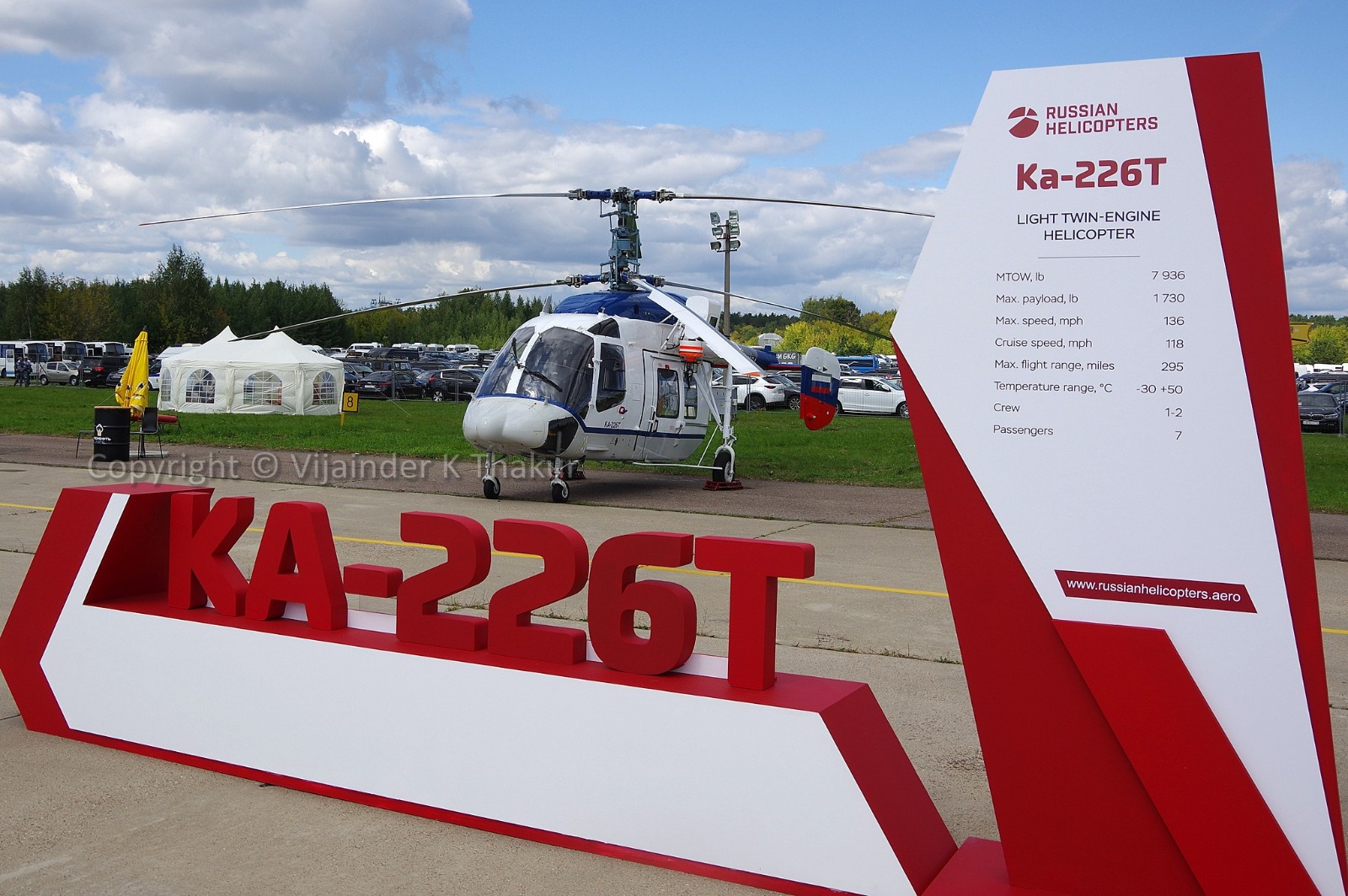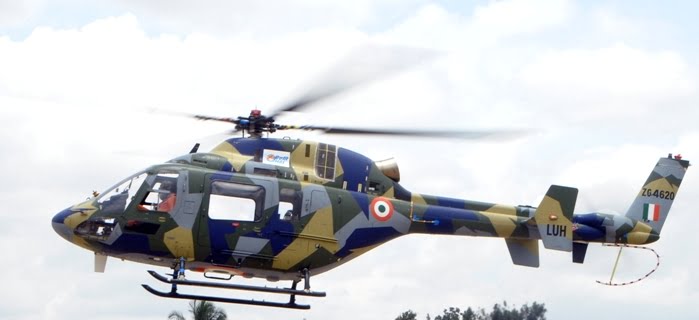Russia is pitching local production of its Ka-226T light helicopter for use by law enforcement agencies and for exports.
On February 7, RIA Novosti reported that Rosoboronexport will display two newly developed Russian aero-engines at Aero India 2025 – “Product 177C engine, proposed to equip 4++ and 5th generation multirole fighters, as well as the VK-650V – for light multirole helicopters.
“VK-650V is designed for installation on the Ka-226T, a joint Russian-Indian venture for the production of which is registered in India and is awaiting orders from the country’s law enforcement agencies.”
Ka-226T
The Ka-226T is a light, multipurpose helicopter featuring twin coaxial rotors. It has a maximum takeoff weight of 3.6 tons and a payload capacity of up to 1 ton.
A key feature of the Ka-226T is its modularity. The helicopter can be quickly reconfigured with a transport cabin that accommodates up to six passengers or outfitted with specialized equipment modules.
Currently, the Ka-226T is powered by French Arrius 2G1 engines.
Indo-Russian Helicopters JV For Ka-226T Production
In 2015, India and Russia signed an agreement to jointly manufacture Kamov Ka-226T light-utility helicopters at Hindustan Aeronautics Limited (HAL).
As per the agreement, India and Russia were to produce at least 200 Ka-226T helicopters for the Indian Armed Forces, with additional units potentially manufactured for civilian use and export.
Under the contract:
- The first 40 helicopters were to be produced in Russia by JSC Kumertau Aviation Production Company and assembled in India.
- The remaining 160 units were to be manufactured and assembled in India, with a progressively increasing level of localization.
The Ka-226T was planned to be produced locally by Indo-Russian Helicopters, a joint venture (JV) where:
* HAL holds a 50.5% stake,
* Russian Helicopters holds 42.5%, and
* Rosoboronexport holds 7%.

Setbacks & Project Suspension
In January 2022, the Defence Procurement Board (DPB) reviewed the Ka-226T manufacturing project as part of India’s efforts to reduce dependence on foreign defense equipment. Following the review, the project stalled, likely due to two key factors:
- Development of the Light Utility Helicopter (LUH): The DPB considered HAL’s indigenous LUH program a viable alternative. The LUH, a 3-ton class helicopter, was being developed to meet both military and civilian requirements.
- Restricted Access to French Engines: At the time of contract signing in 2015, the Ka-226T was powered by French Arrius 2G1 engines. However, following geopolitical tensions, France refused Russia access to the engine. Consequently, Russia could not meet its obligations to fully support Ka-226T manufacture in India as OEM.
Fast-Tracked Development of Substitute Engine
Following Russia’s estrangement from France, in 2019, the UEC-Klimov enterprise announced the development of a new VK-650V gas turbine turboshaft engine with a takeoff power of 650 hp.
The engine’s maximum power output can be varied from 400 hp to 750 hp, depending on the mode of operation.
The VK-650V is intended to replace the French powerplant on Russian Ka-226T and Ansat helicopters. According to UEC, variants of the VK-650V could also be adapted to power drones and hybrid propulsion systems for aircraft.
By December 2020, UEC had built a demonstrator of the VK-650V, which began testing in January 2021. In July 2021, UEC initiated the second stage of testing for the demonstrator engine.
In June 2024, UEC delivered the first prototype VK-650V engines for flight tests on an Ansat helicopter.
Recently, Russia completed the certification of the engine. On February 7, a Rostec press release stated that UEC “has received type certification for the VK-650V turboshaft engine, designed for light helicopters. The VK-650V is now ready for serial production and operational deployment.”
The certification of the VK-650V engine could potentially revive the stalled project to manufacture Ka-226T helicopters in India.
Notably, the VK-650V is the first Russian helicopter engine in the 650–750 hp power class.
Potential Revival With The VK-650V Engine
Since the contract negotiations were suspended, Russia has replaced many foreign components on the Ka-226T with locally manufactured ones. At the time of the contract signing, only 72% of the components were of Russian origin.
As a result, Indo-Russian Helicopters can now begin production of the Ka-226T with a higher level of indigenous content than before.
HAL’s LUH
Meanwhile, HAL LUH received IOC (Initial Operational Clearance) for use by the Indian Army from the Centre for Military Airworthiness and Certification (CEMILAC) on February 05, 2021.
The DAC (Defence Acquisition Committee), on November 2, 2021, accorded AoN (Acceptance of Necessity) for the procurement of 12 LUH from HAL.

On November 29, 2021, MoS for Defence Ajay Bhatt told parliament that HAL would deliver 4 LUHs (2 each year to the IA & IAF) in FY 2022-23 and another eight LUHs (4 each year to the IA & IAF) by 2023-24.
“This would be followed by the manufacture of series production (SP) (variants) of the helicopters by HAL,” Bhatt said.
As of the latest available information, HAL has delivered a total of 12 LUH to the Indian armed forces. These helicopters were part of the initial Limited Series Production (LSP) order, with six allocated to the Indian Army and six to the Indian Air Force. Delivery of serial production aircraft has yet to start.
The LUH is a 3 t helicopter with a range of up to 500 km and a max payload of 500kg.
Conclusion
Local manufacture of the Ka-226T in India is intended to meet the needs of the Indian civil and law enforcement sectors, as well as for export purposes.
HAL is significantly behind schedule in delivering a light helicopter that meets the requirements of the Indian Armed Forces; it could take over a decade for HAL to fulfill these needs.
There is ample market potential for another locally manufactured helicopter that addresses the requirements of paramilitary forces, law enforcement agencies, and the civil sector.
Relying solely on HAL’s LUH program is a high-risk strategy, given HAL’s current track record.
The indigenous content and level of technology transfer (ToT) absorption for both the LUH and the Ka-226T are expected to be similar. Moreover, if the Russians are willing to share some VK-650T technology, their offer could become even more attractive.
A transfer of technology combined with local manufacture would effectively make the Ka-226T an Indian helicopter, much like the BrahMos is regarded as an Indian missile.
- Vijainder K Thakur is a retired IAF Jaguar pilot, author, software architect, entrepreneur, and military analyst.
- VIEWS PERSONAL OF THE AUTHOR
- Follow the author @vkthakur




